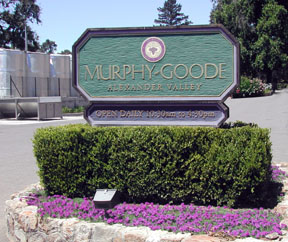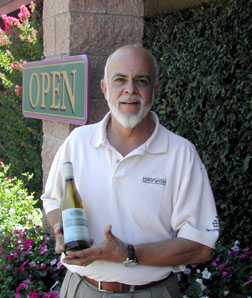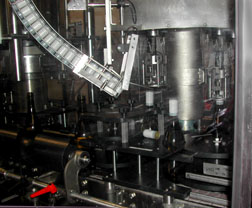 |
| Murphy-Goode
has good answer to the growing cork shortage. |
Cork No More
By Steve Swan
For more than twenty years, the
wine industry has convinced people that fine wine has a cork. That
mindset must change. Alternate forms of bottle closures must be
explored and ultimately accepted. There is a problem with our old
friend The Cork. Wine production is being accelerated all over the
world in every region that will bear vines. This is pushing hard on
cork producers to keep up with demand and like any other
agricultural product, quality suffers with high volume output. In
years past, cork was harvested from trees eight to ten years old.
Now corks are made from four year old trees grown in forests which
are too large due to increasing demand.
So whatís wrong with the modern
cork? Some of them contain a "dead spot"--a little pocket
of bad cork, which reacts with the wine as it rests in the bottle
creating a compound known as 246 Trichloricanisol, which is the
cause of cork tainted or what is simply called "corked
wine." This compound flattens out or dulls what is referred to
as "the mid-palate fruit." There may be fruit at the
beginning and a decent finish at the end, but the wine has no
character--the middle is "hollow." This is capped off with
a musty smell not unlike old wet cardboard.
 Fifteen
years ago, 1-2 out of 100 bottles had this syndrome. Now it is 6 - 8
out of 100. These bottles are generally returned to the vintner, but
the real problem is unreported cases where someone buys a wine they
once enjoyed in the past-- itís a little cork tainted--it has no
character, they donít know itís corked, they just donít like
it and wonít buy it again. Lost customers rarely return.
Fifteen
years ago, 1-2 out of 100 bottles had this syndrome. Now it is 6 - 8
out of 100. These bottles are generally returned to the vintner, but
the real problem is unreported cases where someone buys a wine they
once enjoyed in the past-- itís a little cork tainted--it has no
character, they donít know itís corked, they just donít like
it and wonít buy it again. Lost customers rarely return.
Some vintners tried plastic corks,
which are hard to pull, plus one can break the bottle during the
removal process. Even though the cork is synthetic, it implies the
wine could be laid down for a year or two but when revisited, it
tastes like plastic--another problem to fix.
One way to fix it is with a twist
top cap, according to Mark Pape, marketing coordinator for Murphy
Goode Winery in Geyserville. Their Chardonnay, aptly called
"Tin Roof," is on the cutting edge of twist- top
technology. Unlike typical wine screw caps, they use a Canadian
process called a Stelvin Closure, which uses specially molded caps
made of a thicker gauge metal, which are pressed onto the bottles.
Itís not actually a twist top until the wine is opened. The
message is: Take this wine home and drink it tonight knowing it
would likely be less tannic, less oaky, more fruit driven.
 There
is an atmosphere in an aging bottle of corked wine. It involves
dissolved oxygen in regards to the corkís reaction with the wine
itself and the airspace in the bottle. This reaction is responsible
for the more sophisticated aspects of aged wine such as "bottle
bouquet." The twist top is hermetically sealed, so for
immediate consumption, it makes sure the wine is in the same
condition as when it was bottled. How it will affect the ageability
of wine is the curiosity. Will it allow dissolved oxygen at the rate
to age a premium red wine at a natural pace, or will there be side
effects like the plastic corks?
There
is an atmosphere in an aging bottle of corked wine. It involves
dissolved oxygen in regards to the corkís reaction with the wine
itself and the airspace in the bottle. This reaction is responsible
for the more sophisticated aspects of aged wine such as "bottle
bouquet." The twist top is hermetically sealed, so for
immediate consumption, it makes sure the wine is in the same
condition as when it was bottled. How it will affect the ageability
of wine is the curiosity. Will it allow dissolved oxygen at the rate
to age a premium red wine at a natural pace, or will there be side
effects like the plastic corks?
Murphy Goode is bottling each
varietal both corked and twist topped under identical conditions,
which will be revisited every six months to watch how they develop.
There will also be chemical laboratory analysis to see how they
differ, particularly with regard to dissolved oxygen. Slowly, over
time, age-worthy wines will be available with twist-top closures
once they prove themselves. This is tricky because the wine industry
has instilled the importance of a cork. For now, high quality wines
will have one.
To dispel the notion that the
Stelvin Closure is just a cheap package, the specially molded caps
and bottles are actually more expensive than regular bottling. The
machine, that accomplishes this is a marvel. Completely enclosed in
glass, the bottles are unboxed by hand and sent into the first
stage--a large wheel called the orbiter. When each bottle is upside
down, it is blown out with air to remove any dust and is then "sparged"--filled
with dry nitrogen, which is heavier than air. The bottles move to
the second stage where they are filled with wine and then onto stage
three where the cap is dropped onto the neck and pressed into place.
After that, out of the machine to be boxed by hand. Be assured at
this point, the wine will never be cork tainted!
To look elegant when opening,
grasp the Stelvin Closure firmly with a dampened towel and turn the
bottle. Never again will the cork be accidentally pushed into the
wine. There is, however, one drawback with the twist top. All our
lives, our mothers told us to "put the cap back on." So
when pouring a second glass of wine, it wonít come out of the
bottle. But youíll know what to do . . .